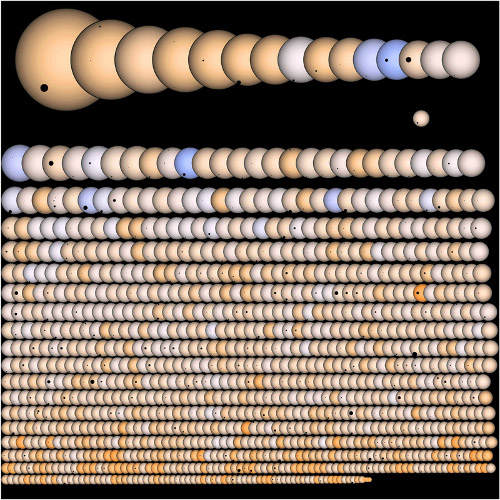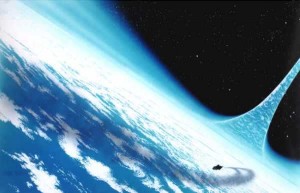Centauri Dreams
Imagining and Planning Interstellar Exploration
Under a Sri Lankan Moon
Looking to put things into perspective? The recent Kepler illustration of the 1235 candidate planets thus far identified, each shown in transit, is something to revel in. The image, shown below, offers a sweeping look at the range of stellar sizes that accomodate planets, and bear in mind that these are the planets that by the luck of the draw happen to be visible in transit, a small percentage of the stars Kepler is able to look at. We clearly live in a galaxy that is swarming with planets. Be sure to click on the image to blow it up to full size so you can have a better view of the distant Kepler worlds.
Image: Kepler monitors a rich star field to identify planetary transits by the slight dimming of starlight caused by a planet crossing the face of its parent star. Here all of Kepler’s planet candidates are shown in transit with their parent stars ordered by size from top left to bottom right. Simulated stellar disks and the silhouettes of transiting planets are all shown at the same relative scale, with saturated star colors. Of course, some stars show more than one planet in transit, but you may have to examine the picture at high resolution to spot them all. For reference, the Sun is shown at the same scale, by itself below the top row on the right. In silhouette against the Sun’s disk, both Jupiter and Earth are in transit. Credit: Jason Rowe / Kepler Mission.
Shaping a Life by Looking at the Sky
Sometimes an image can change a person’s future — who knows what budding scientist might see something like this and decide, early in his or her life, to embark on a career in astronomy? The things that shape our fortunes are often all but invisible to those around us. I was thinking about this while reading an essay by Ray Jayawardhana (University of Toronto) in the New York Times. The astrophysicist recalls walking as a child with his father in the family garden in Sri Lanka, and being told, as they looked at the Moon, that people had walked on its surface. The boy was astounded, and out of that wonderment grew a career. I couldn’t help but wonder what things I might have said to my own children that changed their direction, perhaps without my realizing it. I hope Jayawardhana’s father is still alive so he can read about his gift.
The essay is excerpted from Jayawardhana’s new book Strange New Worlds: The Search for Alien Planets and Life Beyond Our Solar System (Princeton University Press, 2011), which I’ll review in these pages as soon as I’ve finished it. Suffice it to say that an astrophysicist who is also an award-winning science writer knows how to write compellingly, as he does in this essay, musing on the schoolchildren of today and their sense of wonder when they see images from the surface of Mars or in orbit around Saturn. Ahead lie vistas of planets around other stars, places we can’t see but are slowly coming to understand.
I should qualify that by noting that we do have a few direct images of alien worlds, but we’re working toward something much better, space missions of the sort envisioned by Webster Cash, some of whose occulter designs offer the prospect of looking at a distant exoplanet closely enough to view its continents and seas. That technology may be further away financially than it is scientifically — once we commit to missions like these, we’re learning rapidly how to build them, and views like Cash talks about might be only a matter of two or three decades away if the budgetary situation weren’t so problematic. In any case, they’re certainly something that seems achievable in this century.
The Meaning of Life Elsewhere
Jayawardhana is interested in what happens when we detect signs of life from another world. We live in a culture where such detections are depicted as cataclysmic events, a momentous radio reception, or the landing of a spacecraft hostile or otherwise. But given the distances between the stars and the daunting problems of interstellar flight, Jayawardhana believes the discovery of life elsewhere will be slow and, perhaps, anything but sensational:
The evidence may be circumstantial at first — say, spectral bar codes of interesting molecules like oxygen, ozone, methane and water — and leave room for alternative interpretations. It may take years of additional data-gathering, and perhaps the construction of new telescopes, to satisfy our doubts. Besides, we won’t know whether such “biosignatures” are an indication of slime or civilization. Most people will likely move on to other, more immediate concerns of life here on Earth while scientists get down to work.
And if SETI finally scores a hit? That would indeed be a breakthrough moment, but what would likely follow would be decades of analysis as we tried to work out the contents of the message. In either case, the sheer knowledge that life can be found in a different part of the universe would mark a turning point in intellectual history. And the SETI detection, no matter through what form of SETI it could be achieved, would tell us that not only life but intelligence was observing the cosmos with us. These are the kinds of changes that make their way into a society’s philosophy, slowly but utterly transforming our perceptions long after the initial shock of discovery wears off.
Jayawardhana again:
I happen to be an optimist. It may take decades after the initial indications of alien life for scientists to gather enough evidence to be certain or to decipher a signal of artificial origin. The full ramifications of the discovery may not be felt for generations, giving us plenty of time to get used to the presence of our galactic neighbors. Besides, knowing that we are not alone just might be the kick in the pants we need to grow up as a species.
That’s a view that mirrors my own optimism, one that suggests that while we are impatient for immediate results, waiting a few decades to confirm that we are not alone is insignificant compared to how long our species has speculated on the question. Will we find evidence of life, and perhaps of intelligent life, within our own lifetimes? Nobody can know, but I’m all for the kind of speculation that Duncan Forgan and Martin Elvis engaged in in the paper we discussed yesterday. We need to be creative in looking for extraterrestrial intelligence. We need to think of Ray Jayawardhana’s father pointing at the Moon, and recall the sudden moments of astonished insight we’ve had in our own lives when suddenly our own personal cosmos snapped into focus.

Asteroid Mining: A Marker for SETI?
Having just finished Iain Banks’ The Player of Games, I’m thinking about the ‘orbitals’ he describes in his series of novels about the Culture, a vast, star-crossing civilization that can build space habitats in the form of massive rings. Orbitals are smaller than the kind of ‘ringworld’ Larry Niven envisioned, but huge nonetheless, bracelets of super-strong materials housing billions who live on their inner surfaces as they orbit a parent star. The visual effects Banks pulls off in describing these habitats are spectacular. And now a new paper by Duncan Forgan (University of Edinburgh) and Martin Elvis (Harvard Smithsonian Center for Astrophysics) has me wondering about the kind of mining activities it would take to produce the raw materials for such constructs.
Forgan and Elvis are interested in what they describe as a multi-wavelength, multi-signal approach to SETI. We’re used to the idea of huge radio dishes listening for extraterrestrial signals, but SETI is evolving through the use of optical methods, and moving in another tangent into ways of searching for extraterrestrial artifacts on the grand scale, like Dyson spheres. Throw in our ongoing hunt for terrestrial-class exoplanets through missions like Kepler and you have a broadly based strategy open to the detection of another civilization. The authors’ new paper suggests adding one more place to look: In the debris disks around other stars, where we might find signs of asteroid mining for raw material.
Image: Iain Banks’ Consider Phlebas has appeared with a number of different covers, but this one gives you a sense of the scope of the ‘orbitals’ he writes about, vast technological ‘bracelets’ on which billions live. What would it take to produce the raw materials for an orbital? Would we be able to detect such work as it progressed?
Data Mining in a Debris Disk
Debris disks are what’s left over when the gaseous disks around young stars go through their normal evolution, leaving rocky and icy debris in various sizes, like the comets and asteroids found in our own Solar System. We’ve been learning a great deal about debris disks through spectroscopy and imaging ever since the first detection of such a disk around the star Vega, back in the 1980s. These days, we have finely tuned instruments like the Herschel Space Telescope and Spitzer that can provide a wealth of new data. How could we use that data to search for potential evidence of an extraterrestrial intelligence manipulating a debris disk?
It’s a fascinating notion (and thanks to Adam Crowl for calling my attention to this paper). The authors assume that the engineering limitations we have experienced in our own history will also hold for alien cultures. Like us, they will need large quantities of raw material to build the structures their civilization requires. And like us, if we are ever to build a spacefaring civilization, they will need to mine such materials as they move into nearby space, building space vehicles and large habitats as sections of the population move off-planet. Both biological and post-biological civilizations will, then, need the resources demanded by their own growth.
From our perspective, targeted asteroid mining (TAM) presents high initial costs but great potential for profits, lowering the costs of manufacturing future technologies. In fact, Forgan and Elvis argue that the expertise we would gain by creating the necessary infrastructure for asteroid mining could be brought to bear on other aspects of space exploration. Given its hazards, asteroid mining is likely to be turned over quickly to automated workers, putting an emphasis on developing advanced artificial intelligence as we evolve a post-biological culture.
From the paper:
ETIs which have similar economic concerns to ours will eventually find extraplanetary mining projects desirable as their own resources become depleted (provided of course they are sufficiently technologically advanced). We suggest the complexity of TAM missions are such that most species capable of it have the potential to become truly space-faring. If technological civilisations more advanced than ours exist in the Galaxy, a distinct possibility given the estimated median age of terrestrial planets being around 1 Gyr older than Earth (Lineweaver, 2001), and asteroid mining is a common activity which underpins their existence, then searching for signatures of TAM is an appropriate activity for SETI to undertake.
The Signature of Targeted Mining
All of which leads us to the kind of artificial observational signals we might hope to detect. The paper studies this question in relation to the Vega debris disk and finds three kinds of disequilibrium that might be created by asteroid mining at a large scale. The extraction of specific minerals and elements will create an imbalance in the disk, and the authors note the likelihood of iron and nickel mining, these being of practical use in large-scale space engineering projects, along with rarer elements such as platinum and palladium, useful in technological innovation. A sharp depletion in several of these species would be a potential marker.
So, too, would large-scale mining’s effects on the dynamics of a debris disk system, for we would expect these activities to result in the destruction of the larger asteroids in the system. Unusual temperature distributions are a third possible marker, created by the production of dust in the mining process. An anomalous dust source or an unusual temperature gradient in the disk would provide a potentially detectable signal. For that matter, variability in the disk as different locations are mined could also be detectable, although here we’re talking about future instrumentation, as what we have today probably isn’t sensitive enough to make such observations.
Potential for a Detection
Asteroid mining would be no easy catch. In fact, it’s best seen as part of a larger strategy, and may help us primarily in calling our attention to systems that demand further investigation. Having analyzed the signature from the various mining activities, the authors add:
The general trend is somewhat disappointing. For TAM to be detectable, it must be prolific and industrial-scale, producing a large amount of debris and disrupting the system significantly to be detected. However, instrumentation is continually improving, and sensitivity to such effects will only grow, reducing the constraints on detectability. What remains indefatigable with technological advance is the confusion of apparent TAM signals with natural phenomena. A detection of any one of these TAM signals can be explained with a simpler natural model, but detection of many (or all) of these signals in tandem will prove more difficult to model, and hence TAM more difficult to discount as a possibility.
So targeted asteroid mining appears unlikely to provide us with a conclusive detection of an extraterrestrial civilization, but tentative signals seen in unusual dust size distributions or deficits in chemical composition could be markers that tell us to look at a system more closely. Usefully, the markers of asteroid mining would, unlike biomarkers in an atmosphere, indicate not just life but an intelligent, technology-driven culture. For that reason, the authors argue that searching for asteroid mining signatures is a useful addition to the multi-wavelength, multi-signal SETI strategy that is now evolving as we extend our hunt far beyond conventional methods.
The paper is Forgan and Elvis, “Extrasolar Asteroid Mining as Forensic Evidence for Extraterrestrial Intelligence,” accepted for publication in the International Journal of Astrobiology (preprint). And if you’re not familiar with Iain Banks, do look into his novels about the Culture. His plots are ingenious, but I continue to marvel at his visual sense, and always take away images of places that are both astounding and inspiring. Oh to see technology used like this!

Carnival of Space 190
Here’s the latest in the weekly collection of space writing known as the Carnival of Space, in which people with their eyes on the stars go to work to explain the latest findings. Let’s start with the Sun, for even as we push our investigations of distant exoplanets, we have much to learn about the nearest star, as our recent discussion of the Solar Probe Plus reminds us. Launching this week’s Carnival, Vega 0.0 explains the plasma beta parameter, the ratio of gas pressure to magnetic pressure on the Sun, in an environment where plasma behaves like a fluid.
In his Astroblog, the ever reliable Ian Musgrave offers up a review of Stellarium 0.10.6.1. Stellarium, for those not already acquainted with it, is a great, free photo-realistic planetarium program that amateurs should find helpful. Does Ian like it? Evidently so, given his description of the piece as an ‘enthusiastic Fan Boi review.’ And having worked with Stellarium myself, I can see why he’s enchanted with its possibilities. As Ian notes: “I’ve used the free planetarium program Stellarium since version 0.9, and it is no secret that it is my favourite planetarium program for unaided eye observation, and for illustrating aspects of the sky to school groups and the general public. With version 10.6.1 the Stellarium development team have produced a program that I truly love.”
An overview of risk at NASA, highlighting some of the riskier decisions in the past as well as some safe decisions made more recently, is the focus of a recent post by Amy Shira Teitel at Vintage Space. Risk is one thing when under tight time constraints and backed with a budget equaling 4 percent of GDP in the mid-1960s. But even that couldn’t prevent the disaster of the Apollo 1 fire. Read Amy’s thoughts on how NASA has managed the risk game in the years since. Some of these risks don’t involve lives but hardware, as the tricky operation of our Mars rovers demonstrates.
A long Chandra observation of Tycho has revealed a pattern of X-ray ‘stripes’ never before seen in a supernova remnant. As the Chandra Blog points out, “These stripes may provide the first direct evidence that supernova remnants can accelerate particles to energies a hundred times higher than achieved by the most powerful particle accelerator on Earth, the Large Hadron Collider.” These results may give us new insight into the origin of cosmic rays.
Starry Crittters also takes a look at Tycho’s supernova remnant, exploring a striking image showing what John Williams describes as ‘cotton-like clouds of dust and gas seen in the expanding bubble from the blast.’ The stripes that show up particularly well in the X-ray imagery help to support theories about magnetic fields amplified by supernova blast waves. The two posts show us how much the 450-year old supernova remnant has to teach us today.
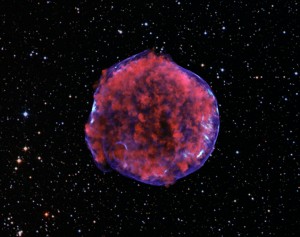
Image: This image comes from a very deep Chandra observation of the Tycho supernova remnant, produced by the explosion of a white dwarf star in our Galaxy. Low-energy X-rays (red) in the image show expanding debris from the supernova explosion and high energy X-rays (blue) show the blast wave, a shell of extremely energetic electrons . These high-energy X-rays show a pattern of X-ray “stripes” never previously seen in a supernova remnant. Credit: X-ray: NASA/CXC/Rutgers/K.Eriksen et al.; Optical: DSS.
Carolyn Collins Petersen, AKA The Spacewriter, gives us her wide-ranging thoughts on skygazing, life on Mars and Hugo Chavez. That life on Earth might have its roots on Mars is fascinating in itself, but this was also the week when the strongman of Venezuela opined that ancient life on Mars was probably destroyed by the depredations of capitalism. “…there you go,” writes Carolyn. “Astronomy and planetary science lead one down some interesting paths, and not always scientific ones.” True, and the beauty of blogging is the freedom it gives us to range widely through topics looking for the threads that connect them together, as The Spacewriter does so well here.
WeirdWarp looks at how a planet or a moon acquires an atmosphere and then loses it. Chris Dann is interested not only in incoming materials from comets and asteroids but the escape of atmospheric gases into space. The question has interesting exoplanet implications, as witness the case of HD 209458b, about as close to a star as a planetary atmosphere can survive. Earth’s future? The Sun’s slow brightening (10 percent every billion years) has consequences that Chris explores.
Music of the Spheres reports on a visit to Space Expo, a space museum in Noordwijk, Netherlands that is also the visitor center for the European Space Agency’s technical development center (ESTEC). Lucky guy, to be traveling in Europe on business anyway, and to discover that one of your stops is the European Space Research and Technology Centre! I would have enjoyed the walk-through of the ISS modules described here.
The Navy’s anti-missile Aegis systems are being upgraded with anti-ballistic missile capabilities starting in 2012, and more upgrades will follow. NextBigFuture tells us that tests have shown 84 percent success rate with intercepts. That surpasses the performance of other systems in the planned missile defense network. The Aegis Combat System is an integrated naval weapons system now produced by Lockheed Martin.
Several brown dwarf stars have been found by European and NASA telescopes. One might be a Y-class brown dwarf. The Y-class family would include brown dwarfs that are cool enough to have water vapor in their atmosphere capable of condensing to form clouds and water. This would be quite a find, as another story in NextBigFuture notes: “Observations with ESO’s Very Large Telescope and two other telescopes have shown that this pair is the coolest pair of brown dwarfs found so far. The colder of the two components… is a candidate for the brown dwarf with the lowest temperature ever found — the surface temperature is similar to that of a cup of freshly made tea.” That one caught my interest as well in this Centauri Dreams post.
Closing out a trio of entries, NextBigFuture then discusses the Air Force and DARPA, which are days away from another X-51 hypersonic rocket test. Four of the ‘Waveriders’ were built for the Air Force by teams at Boeing and Pratt & Whitney Rocketdyne. You may remember an X-51A test last year that took the craft to Mach 5 under scramjet power.
Jupiter’s faded southern belt is turning red again! And about time — the belt had faded to white in early 2010, and based on past such occurrences, we knew it took about a year for the belt to come back to normal visibility. Emily Lakdawalla has photos in the Planetary Society Blog showing the belt’s return.
New Studies indicate that there are likely billions of other worlds in our galaxy alone. The latest work on Kepler data comes up with 1.4 to 2.7 percent of Sun-like stars as the figure expected to have planets the size of the Earth orbiting within the habitable zone. The numbers work out to something like 2 billion in our galaxy, as Paul Scott Anderson explains in the Meridiani Journal.
Nancy Atkinson at Universe Today clues in on Mauna Kea, on the Big Island of Hawaii, which is one of the best places in the world for ground-based astronomy. Nancy’s trip to the summit to see the multitude of giant telescopes there (13!) was scrubbed by weather, but she did get a behind the scenes tour of the W. M. Keck Observatory headquarters in Waimea. It turns out there is an operations room for each of the twin 10-meter Keck telescopes — the astronomers tend to work out of these rather than at the actual telescope site on the summit. Nancy’s photos will have you wanting to book that Hawaiian trip sooner rather than later.
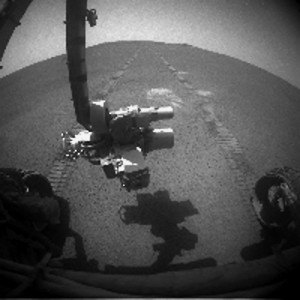
Finally, Stuart Atkinson’s The Road to Endeavour follows the fortunes of the doughty Opportunity rover, now putting Santa Maria behind it and heading for Endeavour crater. I like the spirit of this post, which reminds us of the journey the rovers have taken us on, so far beyond what we had expected: “The road ahead is long, and there’s not going to be a lot on it to see, or make pretty colour views of, but every sol from now on will take us a little closer to Endeavour… every sol from now on we’ll see those faraway hills grow a little larger, a little sharper… every sol from now on we’ll be one sol closer to conducting fascinating science on the rim of an enormous, ancient martian crater that could re-write the science books for generations to come…”
Image: Opportunity’s tracks leading away from the Santa Maria Crater. Credit: JPL.

Philosophy, Breakfast and Life Elsewhere
Because I’m immersed in Laura Snyder’s wonderful book The Philosophical Breakfast Club (Broadway Books, 2011), I’ve been thinking lately about William Whewell. Long the master of Trinity College, Cambridge, Whewell helped bring sound, inductive methods to the fore in the science of his day, created models of international cooperation in scientific investigations through his studies of the tides, founded the discipline of mathematical economics, studied crystallography and, in one memorable episode, became involved in a 19th Century imbroglio over alien life.
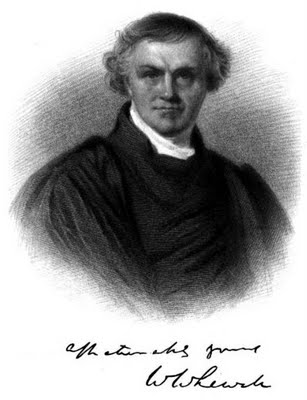
This morning I want to focus on that incident, but it’s just one of the numerous episodes Snyder recounts in her history, which follows four remarkable men — Whewell, mathematician Charles Babbage, astronomer John Herschel (son of William) and economist Richard Jones — through a lifetime of friendship and scientific inquiry. What’s fascinating about Whewell’s brush with the topic of extraterrestrial life is that it reveals how widespread was the idea of such life in the 19th Century. Indeed, Whewell’s problem was that he came around to skepticism about life among the stars, a position all but unthinkable to many in the scientific community of his day.
A 19th Century Read on Extraterrestrial Life
In the late 1850’s Whewell (pronounced ‘HOO-ell’) had a bestseller on his hands in the form of a book called Of the Plurality of Worlds. The book was a sharp departure from his earlier work some twenty years before, when he had argued for the possibility that other stars might have planets with intelligent life on them. The new book argued against the idea of intelligent life anywhere but the Earth, prompting scathing attacks from some reviewers. Here’s one critic who sees Whewell in positively medieval terms:
We scarcely expected that in the middle of the nineteenth century, a serious attempt would be made to restore the exploded idea of man’s supremacy over all other creatures in the universe; and still less that such an attempt could have been made by one whose mind was stored with scientific truths. Nevertheless, a champion has actually appeared, who boldly dares to combat against all the rational inhabitants of other spheres; and though as yet he wears his visor down, his dominant bearing, and the peculiar dexterity and power with which he wields his arms, indicate that this knight-errant of nursery notions can be none other than the Master of Trinity College, Cambridge.
So wrote one reviewer in the London Daily News. I was startled when reading this section of Snyder’s book to learn just how common, and accepted, the idea of extraterrestrial life was in the mid-19th Century. One David Brewster, who was driven almost to apoplexy by Whewell’s new book, took on the master of Trinity with a will, arguing that life was to be found just about everywhere. Brewster maintained that Jupiter was inhabited by beings with ‘a type of reason of which the intellect of Isaac Newton is the lowest degree.’ And he was hardly alone. Here’s Snyder on the matter:
Ever since Copernicus had shown that the earth was not the center of the universe, but just a planet circling the Sun like all the others, most people assumed that other planets could, like earth, contain intelligent life. This notion that there was a ‘plurality of (inhabited) worlds’ had even become an accepted tenet of natural theology, it being believed that empty planets, devoid of life, would indicate wastefulness on the part of God. Why would God have created so many worlds, if not to be the seats of life? Babbage had ended his book On the Economy of Machinery and Manufactures with a rhapsodic depiction of the vastness of our universe, filled with so much life: as all these planets and moons and stars were ‘the work of the same Almighty Architect,’ he argued, it was not credible that ‘no living eye should be gladdened by their forms of beauty, that no intellectual being should expand its faculties in deciphering their laws.’
Solar Beings, and Bat People on the Moon
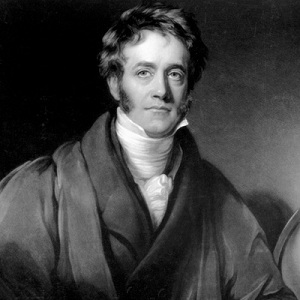
For his part, astronomer John Herschel often speculated on intelligent life in the cosmos and believed for a time that there were rational beings living on the Sun, as well as on the planets and their various moons. The odd belief about life not near but on a star echoed Herschel’s father William, who argued that below its hot atmosphere, the Sun had a surface cool enough to support life. John Herschel’s Treatise on Astronomy (1833) made the case for some of these views, and was picked up by one Richard Adams Locke, who created a series of articles for the New York Sun out of whole cloth in 1835, claiming that Herschel had observed bat-like men on the Moon, not to mention horned bears and bipedal beavers, through a fabulous new telescope.
Image: John Herschel in the 1830s, from a portrait by H.W. Pickersgill.
The story took off in the press while an oblivious Herschel was working at an observatory on the Cape of Good Hope, with the American writer Edgar Allan Poe calling the series of articles ‘decidedly the greatest hit in the way of sensation…ever made by any similar fiction.’ The uproar over the hoax finally settled down, although an exasperated Herschel, who said he was ‘pestered from all quarters with that ridiculous hoax about the Moon,’ never stopped believing that intelligent life was widespread in the universe. He did, however, give up on the idea of life on the Sun.
Whewell is the one who stands out in all this, however, because the tenacity of the attacks on him, especially those of David Brewster, neatly made the point he wanted to make. Whewell was, above all, a believer in the need for proper scientific method, and the need to educate the public in its workings (his History of the Inductive Sciences was a major influence on Darwin). This is the man who coined the word ‘scientist,’ a man who believed in finding evidence rather than merely making assertions, and he rightly pointed out the problems with the idea of intelligent life on places like Jupiter which, given the astronomical knowledge of the day, seemed anything but hospitable to it. He would also argue the case of extraterrestrial life from the standpoint of natural theology, but he never confused the latter with scientific method.
A famous slur on Whewell says that his book was an attempt to show that ‘through all infinity, there was nothing as great as the Master of Trinity.’ But even though we have far different views about life in the universe today — and with the kind of painstaking science Whewell believed in, we are learning more every day — the fact remains that the enthusiasm for extraterrestrial life Snyder depicts in the early Victorian era was more like a popular mania than a sustainable belief. We still don’t know whether there is intelligent life on other worlds, though we’re taking the best steps we can to learn, but the history of our fascination with extraterrestrials is instructive. It tells us that while enthusiasm is infectious, we have to keep our eyes on the prize: Reliable data.
Breakfasts to Remember
The Philosophical Breakfast Club is a gem, and anyone interested in the history of science or the cultural realm of 19th Century Britain will find it absorbing. I haven’t had time here to do more than sketch an episode that should intrigue Centauri Dreams readers, but realize that Snyder gets into Charles Babbage’s obsession with building the kind of machinery that would turn into today’s computers, and Herschel’s contributions not only to astronomy but to photography and even botany, while the little heralded Jones is shown as a poorly disciplined but highly talented man who shaped our modern understanding of economics. These four interacted from the 1810s to the 1870s, driven by science and a common passion to change the world.
The breakfast club? Babbage, Herschel, Jones and Whewell began to meet on Sunday mornings after chapel services at Cambridge in 1812, when they were all students there. I have to pass along Snyder’s description of the kind of breakfasts the four young men consumed:
When the men arrived, they were relieve to find a roaring fire that had been prepared by Herschel’s ‘gyp,’ or college servant. The mornings during term time were typically cool and damp, and in the winter it was still dark. As they took off their robes and warmed themselves, Herschel would motion for his gyp to go to the kitchen of the college and retrieve the bountiful breakfast he had ordered: tea, coffee, and ‘audit ale,’ so called because it was the best beer, by tradition reserved for the feast or ‘audit’ days; tongue, cold beef, ham, chicken, anchovies, and eggs; toast, muffins, crumpets; honey, marmalade, and butter (which was shaped into rolls an inch in diameter and sold in town by inches, ‘measured out by compasses, in a truly mathematical manner,’ as the novelist Maria Edgeworth put it after a visit to Cambridge around this time).
Imagine doing anything but sleeping after a repast like that! But these four would then go on to discuss the topic of the week, often one of the writings of Francis Bacon (1561-1626), whose great belief was that science could be used to change the fabric of society and improve peoples’ lives. And as Bacon wanted to find a logic applicable to both the study of nature and the study of men, an all-encompassing logic, so the four young Cambridge students would spend their lives looking for ways to promote and encourage the new science. Their rivalries, intrigues and passions in a lifetime of dedicated research take on vigorous life in Snyder’s expert hands.

Pedal to the Metal
We have a long way to go before we can get a probe to another star in the space of a human lifetime. The figure always cited here is the heliocentric speed of Voyager 1, some 17.05 kilometers per second, which is faster than any of our outward bound spacecraft but would take well over 70,000 years to reach Alpha Centauri, assuming Voyager 1 were pointed in that direction. New Horizons is currently making 15.73 kilometers per second on its way to a Pluto/Charon flyby in July of 2015, impressive but not the kind of speed that would get us to interstellar probe territory.
Interestingly, the fastest spacecraft ever built weren’t headed out of the Solar System at all, but in toward the Sun. The Helios probes were West German vehicles launched by NASA, one in 1974, the other in 1976, producing successful missions to study conditions close to the Sun for a period of over ten years. The orbits of these two craft were highly elliptical, and at closest approach to the Sun, each reached speeds in the range of 70 kilometers per second. Helios II, marginally faster, lays claim to being the fastest man-made object in history.
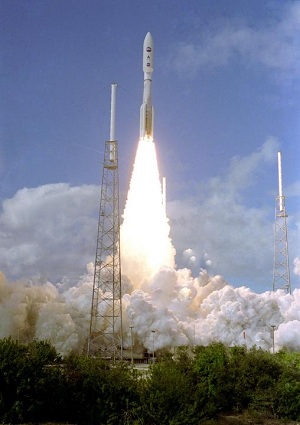
It’s fun to juggle these numbers even as we think about how far we have to go before an interstellar probe becomes a possibility. If the goal is to reach Alpha Centauri with a mission lasting, say, forty years, then we need a tenth of lightspeed, or roughly 30,000 kilometers per second. That makes .10c a figure of distinction, because it creates a mission that can be built, flown and studied to completion by the same team. I’ve long argued that the goal of missions that could be completed within the lifetime of a researcher is one we’ll ultimately have to ignore, because for a time our deep probes beyond the system are going to take a much longer time than that. But get us to a tenth of c and that goal becomes possible, at least in terms of Centauri A and B.
Image: Smoke and steam fill the launch pad in January of 2006 as New Horizons roars into the blue sky aboard an Atlas V rocket. No craft ever had a faster Earth escape velocity, but the fastest spacecraft now exiting our Solar System is Voyager 1. Credit: NASA.
With the recent success of the MESSENGER probe in reaching Mercury orbit, it’s worth pointing out that another mission design from the Johns Hopkins University Applied Physics Laboratory (JHU/APL) would create a spacecraft even faster than the Helios probes. Like Helios, the Solar Probe Plus is headed for the Sun, with a goal of studying the outer corona. In its approach to within 8.5 solar radii (that’s just 0.04 AU), Solar Probe Plus would achieve a velocity of close to 200 km/sec, three times faster than Helios II. In interstellar terms, that works out to 6450 years to reach Centauri A and B, better than Voyager 1 but a numbingly long voyage even for a generation ship. Thus the difference between where we are now and where we would like to be.
New Horizons just passed the orbit of Uranus on March 18, described by an update on the mission site as “the fastest spacecraft ever launched.” And in a sense, that’s also true — New Horizons left Earth orbit traveling faster than any previous vehicle launched into interplanetary space. But the expected speed at Pluto/Charon encounter is about 14 kilometers per second, and it’s unlikely that any conceivable gravitational assist in the outer system could boost its speed to surpass Voyager 1’s. In any case, a recent tweet from the New Horizons team says there will be no Pluto gravity assist because it would impinge upon the scientific investigation of Pluto and its moons.
The good news, though, is that New Horizons should have enough fuel after Pluto encounter for one or even two Kuiper Belt Object flybys, targets that will not be selected until 2015. We thus keep our eyes on the coming flyby in the outer Solar System, with every indication that all is well aboard the spacecraft. A successful New Horizons should highlight yet another JHU/APL initiative, the Innovative Interstellar Explorer, a design intended to push out to 200 AU. Slowly, but with ever increasing steps, we’re learning our way around this Solar System and sketching out the regions beyond it. The propulsion challenges ahead are clearly defined, and energizing.

Brown Dwarfs and Planets: A Blurry Boundary
With April approaching, my thoughts turn more and more to the release of the WISE data, which should tell us a great deal about brown dwarfs and other relatively cool objects in our stellar neighborhood. The Wide-Field Infrared Explorer mission hasn’t gained the media attention of a Kepler or a CoRoT because it’s not specifically a planet-hunter and isn’t in the business of turning up small, rocky worlds. But if you’ve been following our discussions here, you know how important a mission this is. We’ll get a bit more than half the data WISE has generated in April, and the rest of the dataset in 2012, by which time we may be able to identify, or else lay to rest the idea of, a gas giant (‘Tyche’) at 15000 AU, or a brown dwarf closer than Alpha Centauri.
It’s at the low end of the temperature range that so much interest is focusing these days, and the fact is that until we can get a read on how common brown dwarfs are, we won’t have a good idea about what kind of stars are most common in the galaxy. Until recently, the M-dwarf population, numbingly hot compared to the average brown dwarf, was assumed to be the most common stellar type, accounting for perhaps 75 percent of all stars. But we need to know the percentage of brown dwarfs, and to understand the various sub-groupings that make up this classification.
On that score, a binary system called CFBDSIR 1458+10, 75 light years from Earth, swims into interesting focus. Here we have two components, CFBDSIR 1458+10A and CFBDSIR 1458+10B, both of which are brown dwarfs, orbiting each other at a distance of about three AU with an orbital period of thirty years. The second brown dwarf (CFBDSIR 1458+10B) is now found to be perhaps the coolest star ever identified, with a temperature being reported on my side of the Atlantic as equivalent to that of a hot cup of coffee — in Europe, ESO is saying it’s as hot as a ‘freshly made cup of tea.’
So poke your finger in a nice, steaming cup of Costa Rica Tres Rios or a fine Darjeeling as the mood strikes you, and ponder a star of this temperature, just hot enough to bring water to a boil. What an intriguing object, as Michael Liu (University of Hawaii) is quick to note:
“At such temperatures we expect the brown dwarf to have properties that are different from previously known brown dwarfs and much closer to those of giant exoplanets — it could even have water clouds in its atmosphere. In fact, once we start taking images of gas-giant planets around Sun-like stars in the near future, I expect that many of them will look like CFBDSIR 1458+10B.”
Liu is lead author of the paper on this work, where he and his colleagues point out that the object in question is 150 K cooler in temperature than any known brown dwarf, making it a candidate for the first member of the proposed Y spectral class. Thus far we just have models that suggest the presence of this class of ultra-cool brown dwarfs with temperatures below 500 K, although two recently discovered objects (UGPS 0722-05 and SDWFS 1433+35) have been considered possible members of the class. With a temperature of 370 K (plus or minus 40 K), the lesser dwarf in the binary Liu is studying would seem to be the best candidate yet.
From the paper:
Overall, CFBDSIR J1458+1013B is the most promising candidate to date for the hypothesized Y spectral class, given its extremely low luminosity, atypical near-IR colors, and cold inferred temperature. While spectroscopy is needed to place it in full context with the known T dwarfs, the singular nature of this object is unambiguous, thanks to our parallax measurement. CFBDSIR J1458+1013B is 1.5-2.0 magnitudes less luminous in the near-IR than any previously known brown dwarf and therefore is cooler than any known brown dwarf. For reference, two magnitudes in absolute magnitude spans most of the T dwarf sequence, from about T0 to T6… On this basis alone, this object is a significant leap.
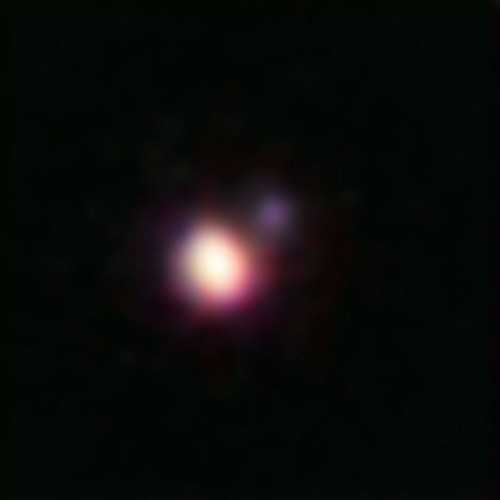
Image: This image of the brown dwarf binary CFBDSIR 1458+10 was obtained using the Laser Guide Star (LGS) Adaptive Optics system on the Keck II Telescope in Hawaii. Adaptive optics cancels out much of Earth’s atmospheric interference, improving the image sharpness by a factor of ten and enabling the very small separation binary to be resolved. This is the coolest pair of brown dwarfs found so far—the colder and dimmer of the two components is a candidate for the brown dwarf with the lowest temperature ever found. This color picture was created from images taken through four different filters at near-infrared wavelengths. Credit: Michael Liu, University of Hawaii.
Usefully, the orbital period is short enough that we will be able to estimate the mass of this binary system over the next few years, helpful information as we probe the limits of mass and star formation. Thus we explore that fascinating and blurry boundary between planet and star. In case you’re wondering, the proposed 370 K temperature for CFBDSIR 1458+10B is about 170 K higher than what John Matese and Daniel Whitmire are proposing for the temperature of Tyche, the hypothesized gas giant in the Oort Cloud. A blurry boundary between planet and star indeed.
The paper is Liu et al., “CFBDSIR J1458+1013B: A Very Cold (>T10) Brown Dwarf in a Binary System,” in press at The Astrophysical Journal (preprint).

